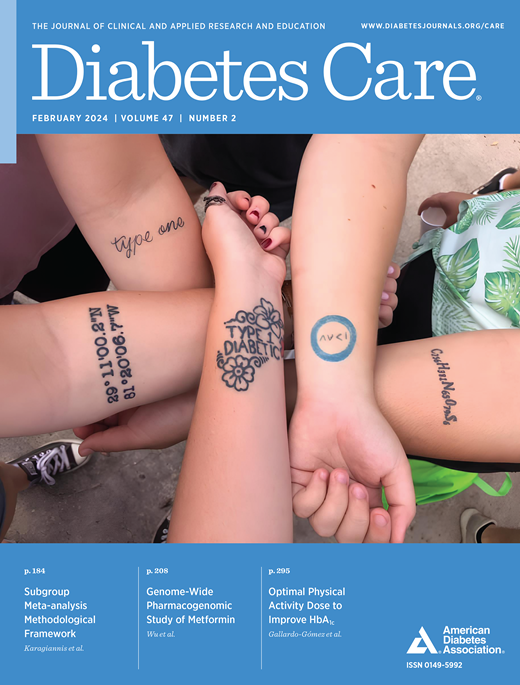PCSK9抑制剂Evolocumab在1型糖尿病患者中的心血管结局和疗效:来自FOURIER试验的见解
IF 16.6
1区 医学
Q1 ENDOCRINOLOGY & METABOLISM
引用次数: 0
摘要
目的评价强化降LDL- c治疗1型糖尿病(T1DM)的临床疗效。研究设计和方法:在高风险受试者(FOURIER)中进一步进行PCSK9抑制的心血管结局研究,将接受他汀类药物治疗的动脉粥样硬化性心血管疾病(ASCVD)患者随机分为evolocumab或安慰剂(中位随访时间为2.2年)。主要终点(PEP)是心血管死亡、心肌梗死、中风、不稳定型心绞痛住院或冠状动脉血运重建术。结果在27,564名参与者中,10,834名(39.3%)患有2型糖尿病(T2DM), 197名(0.7%)患有T1DM。在安慰剂组中,无糖尿病、2型糖尿病和1型糖尿病患者的2.5年PEP Kaplan-Meier率分别从11.0%逐步增加到15.2%和20.4% (P <;0.0001)。在无糖尿病、T2DM和T1DM组,PEP与evolocumab的风险比分别为0.87 (95% CI 0.79-0.96)、0.84(0.75-0.93)和0.66(0.32-1.38),绝对风险降低分别为1.3%、2.5%和7.3%。结论:强化LDL-C降低可能为T1DM和ASCVD患者提供实质性的临床益处。需要在这一人群中进行额外的随机对照心血管结局试验。本文章由计算机程序翻译,如有差异,请以英文原文为准。
Cardiovascular Outcomes and Efficacy of the PCSK9 Inhibitor Evolocumab in Individuals With Type 1 Diabetes: Insights From the FOURIER Trial
OBJECTIVE To evaluate the clinical efficacy of intensive LDL cholesterol (LDL-C) lowering in type 1 diabetes mellitus (T1DM). RESEARCH DESIGN AND METHODS Further Cardiovascular Outcomes Research With PCSK9 Inhibition in Subjects With Elevated Risk (FOURIER) randomized participants with atherosclerotic cardiovascular disease (ASCVD) on statins to evolocumab or placebo (median follow-up 2.2 years). The primary end point (PEP) was cardiovascular death, myocardial infarction, stroke, hospitalization for unstable angina, or coronary revascularization. RESULTS Of 27,564 participants, 10,834 (39.3%) had type 2 diabetes mellitus (T2DM), and 197 (0.7%) had T1DM. In the placebo arm, there was a stepwise increase in the 2.5-year PEP Kaplan-Meier rate from 11.0% to 15.2% to 20.4% in participants with no diabetes, T2DM, and T1DM, respectively (P < 0.0001). Hazard ratios for PEP with evolocumab were 0.87 (95% CI 0.79–0.96), 0.84 (0.75–0.93), and 0.66 (0.32–1.38) in the no diabetes, T2DM, and T1DM groups, and absolute risk reduction was 1.3%, 2.5%, and 7.3%, respectively. CONCLUSIONS Intensive LDL-C lowering may provide substantial clinical benefit in individuals with T1DM and ASCVD. Additional randomized controlled cardiovascular outcomes trials are needed in this population.
求助全文
通过发布文献求助,成功后即可免费获取论文全文。
去求助
来源期刊

Diabetes Care
医学-内分泌学与代谢
CiteScore
27.80
自引率
4.90%
发文量
449
审稿时长
1 months
期刊介绍:
The journal's overarching mission can be captured by the simple word "Care," reflecting its commitment to enhancing patient well-being. Diabetes Care aims to support better patient care by addressing the comprehensive needs of healthcare professionals dedicated to managing diabetes.
Diabetes Care serves as a valuable resource for healthcare practitioners, aiming to advance knowledge, foster research, and improve diabetes management. The journal publishes original research across various categories, including Clinical Care, Education, Nutrition, Psychosocial Research, Epidemiology, Health Services Research, Emerging Treatments and Technologies, Pathophysiology, Complications, and Cardiovascular and Metabolic Risk. Additionally, Diabetes Care features ADA statements, consensus reports, review articles, letters to the editor, and health/medical news, appealing to a diverse audience of physicians, researchers, psychologists, educators, and other healthcare professionals.
 求助内容:
求助内容: 应助结果提醒方式:
应助结果提醒方式:


